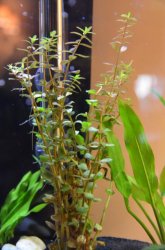TwoTankAmin
Fish Connoisseur
Just a little correction to what Byron posted above:
Dr. Hovanec worked at Marineland's labs which is where is developed Bio Spira which was ultimately replaced by One and Only (they are not the same things). As far as I know the Bio Spira patent, or some similar arrangement, was made to sell it. It was still being produced for use in just SW tanks since. I cannot say if it is still available.
Marineland was bought out by a conglomerate which also owns Tetra. At that time Dr Hovanec bought the Marineland facility and started his own company which producec Oone and Only. However, I believe the patents, or at least the rights to produce the product, are shared with Tetra. At the outset the two products were similar. Hoever, the now differe in at least one respect. Tetra puts some ammonia in the bottle and Dr Hovanec does not. tetra appears to have made some other modifications.
For this reason I always suggest folks use One and Only if at all possible. If one cannot find it, then I suggest Safe Start as the next best choice.
Plants do not uptake nitrite, they take in ammonia (as NH4) and/or nitrate. What the do not do is convert ammonia to nitrite.
And then re the following:
Not as far as i am concerned. While it is difficult to find information on the toxicicty of nitrite to aquatic plants or whether they even use it. the literature indicates nitrite is toxic to land plants for sure. in the absence of scinece showing that aquatic plants are completely different in this respect, I believe nitrite is not used by most plants in our tanks.
 /passel.unl.edu/pages/informationmodule.php?idinformationmodule=1130447042&topicorder=2&maxto=8
/passel.unl.edu/pages/informationmodule.php?idinformationmodule=1130447042&topicorder=2&maxto=8
The reason planted tanks tend not to show nitrite is due to the fact that when plants uptake ammonium, they do not "spit out" nitrite as the bacterial process does. Combine this with the fact than one of the greatest benefits of seeding bacteria during cycling is the effect on nitrite levels. In a normal plantless cycle with no bacterial seeding it takes a build up of nitrite to start the nitrite bacs reproducing to handle it. With seeding there are nitrite bacs ready and waiting to handle nitrite. They should be present in numbers able to handle whatever nitrite is produced by the ammonia bacteria contained in the starter colonies. So as the nitrite begins to be produced, is is all or almost all consumed. And as the ammonia bacs ramp up to handle higher ammonia levels, so too do the nitrite bacteria. In such cases the differing reproduction times of the two bacteria becomes less consequential and one may never actually see nitrite.
The SafeStart is his original biospira formula [if I have the name right] that was sold to Tetra. It quickens the bacteria seeding but is not an instant cycling supplement.
Dr. Hovanec worked at Marineland's labs which is where is developed Bio Spira which was ultimately replaced by One and Only (they are not the same things). As far as I know the Bio Spira patent, or some similar arrangement, was made to sell it. It was still being produced for use in just SW tanks since. I cannot say if it is still available.
Marineland was bought out by a conglomerate which also owns Tetra. At that time Dr Hovanec bought the Marineland facility and started his own company which producec Oone and Only. However, I believe the patents, or at least the rights to produce the product, are shared with Tetra. At the outset the two products were similar. Hoever, the now differe in at least one respect. Tetra puts some ammonia in the bottle and Dr Hovanec does not. tetra appears to have made some other modifications.
For this reason I always suggest folks use One and Only if at all possible. If one cannot find it, then I suggest Safe Start as the next best choice.
Plants do not uptake nitrite, they take in ammonia (as NH4) and/or nitrate. What the do not do is convert ammonia to nitrite.
And then re the following:
Its possible that my Bacopa plants are removing both Ammonia and Nitrite.
Not as far as i am concerned. While it is difficult to find information on the toxicicty of nitrite to aquatic plants or whether they even use it. the literature indicates nitrite is toxic to land plants for sure. in the absence of scinece showing that aquatic plants are completely different in this respect, I believe nitrite is not used by most plants in our tanks.
from http
The Nitrogen Cycle
Ammonium (NH4+) and nitrate (NO3–) are the predominate inorganic forms of nitrogen in soils. Ammonium exists in exchangeable and nonexchangeable forms. Nitrite (NO2) and nitrous oxide (N2O) are present in soil in lesser quantities. Plants normally use nitrogen in only the ammonium and nitrate forms. Nitrite is actually toxic to plants.
 /passel.unl.edu/pages/informationmodule.php?idinformationmodule=1130447042&topicorder=2&maxto=8
/passel.unl.edu/pages/informationmodule.php?idinformationmodule=1130447042&topicorder=2&maxto=8The reason planted tanks tend not to show nitrite is due to the fact that when plants uptake ammonium, they do not "spit out" nitrite as the bacterial process does. Combine this with the fact than one of the greatest benefits of seeding bacteria during cycling is the effect on nitrite levels. In a normal plantless cycle with no bacterial seeding it takes a build up of nitrite to start the nitrite bacs reproducing to handle it. With seeding there are nitrite bacs ready and waiting to handle nitrite. They should be present in numbers able to handle whatever nitrite is produced by the ammonia bacteria contained in the starter colonies. So as the nitrite begins to be produced, is is all or almost all consumed. And as the ammonia bacs ramp up to handle higher ammonia levels, so too do the nitrite bacteria. In such cases the differing reproduction times of the two bacteria becomes less consequential and one may never actually see nitrite.




